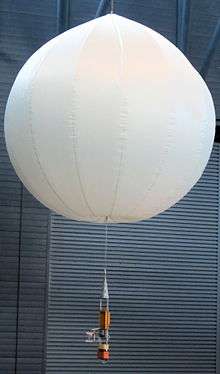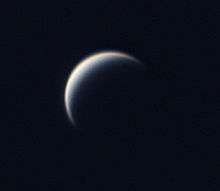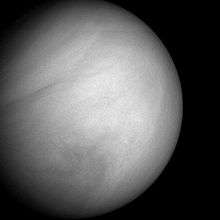Vega 1
|
Vega solar system probe bus and landing apparatus (model) | |
| Names | Venera-Halley 1 |
|---|---|
| Mission type | Planetary science including lander and atmospheric probe |
| Operator | Soviet Academy of Sciences |
| COSPAR ID |
1984-125A 1984-125E 1984-125F |
| SATCAT № |
15432 15858 15859 |
| Spacecraft properties | |
| Spacecraft type | 5VK |
| Manufacturer | NPO Lavochkin |
| Launch mass |
Spacecraft:4,920 kg (10,850 lb) Balloon:21.5 kg (47 lb) |
| Landing mass | 1,520 kg (3,350 lb) |
| Start of mission | |
| Launch date | December 15, 1984, 09:16:24 UTC |
| Rocket | Proton 8K82K |
| Launch site | Baikonur 200/39 |
| Orbital parameters | |
| Reference system | Geocentric |
| Regime | Low Earth |
| Semi-major axis | 6,558 kilometres (4,075 mi) |
| Perigee | 159 kilometres (99 mi) |
| Apogee | 202 kilometres (126 mi) |
| Inclination | 51.5° |
| Period | 88 minutes |
| Flyby of Venus | |
| Closest approach | June 11, 1985 |
| Distance | 39,000 kilometres (24,000 mi) |
| Venus atmospheric probe | |
| Spacecraft component | Vega 1 Balloon |
| Atmospheric entry | 02:06:10, June 11, 1985 |
| Venus lander | |
| Spacecraft component | Vega 1 Decent Craft |
| Landing date | 03:02:54, June 11, 1985 |
| Landing site | 7°30′N 177°42′E / 7.5°N 177.7°E (north of Aphrodite Terra) |
| Flyby of Halley's Comet | |
| Closest approach | March 6, 1986 |
| Distance | ~10,000 km (6,200 mi) |
Vega 1 (along with its twin Vega 2) is a Soviet space probe part of the Vega program. The spacecraft was a development of the earlier Venera craft. They were designed by Babakin Space Centre and constructed as 5VK by Lavochkin at Khimki.
The craft was powered by twin large solar panels and instruments included an antenna dish, cameras, spectrometer, infrared sounder, magnetometers (MISCHA), and plasma probes. The 4,920 kg craft was launched by a Proton 8K82K rocket from Baikonur Cosmodrome, Tyuratam, Kazakh SSR. Both Vega 1 and 2 were three-axis stabilized spacecraft. The spacecraft were equipped with a dual bumper shield for dust protection from Halley's comet.
Venus mission
The descent module arrived at Venus on 11 June 1985, two days after being released from the Vega 1 flyby probe. The module, a 1500 kg, 240 cm diameter sphere, contained a surface lander and a balloon explorer. The flyby probe performed a gravitational assist maneuver using Venus, and continued its mission to intercept the comet.[1]
Descent craft
The surface lander was identical to that of Vega 2 as well as the previous six Venera missions. The objective of the probe was the study of the atmosphere and the exposed surface of the planet. The scientific payload included a UV spectrometer, temperature and pressure sensors, a water concentration meter, a gas-phase chromatograph, an X-ray spectrometer, a mass spectrometer, and a surface sampling device. Several of these scientific tools (the UV spectrometer, the mass spectrograph, and the devices to measure pressure and temperature) were developed in collaboration with French scientists.[1]
The lander successfully touched down at 7°12′N 177°48′E / 7.2°N 177.8°E in the Mermaid Plain north of Aphrodite Terra. Due to excessive turbulence, some surface experiments were inadvertently activated 20 km above the surface. Only the mass spectrometer was able to return data.[2]
Balloon

The Vega 1 Lander/Balloon capsule entered the Venus atmosphere (125 km altitude) at 2:06:10 UT (Earth received time; Moscow time 5:06:10 a.m.) on 11 June 1985 at roughly 11 km/s. At approximately 2:06:25 UT the parachute attached to the landing craft cap opened at an altitude of 64 km. The cap and parachute were released 15 seconds later at 63 km altitude. The balloon package was pulled out of its compartment by parachute 40 seconds later at 61 km altitude, at 8.1 degrees N, 176.9 degrees east. A second parachute opened at an altitude of 55 km, 200 seconds after entry, extracting the furled balloon. The balloon was inflated 100 seconds later at 54 km and the parachute and inflation system were jettisoned. The ballast was jettisoned when the balloon reached roughly 50 km and the balloon floated back to a stable height between 53 and 54 km some 15 to 25 minutes after entry. The mean stable height was 53.6 km, with a pressure of 535 mbar and a temperature of 300-310 K in the middle, most active layer of the Venus three-tiered cloud system. The balloon drifted westward in the zonal wind flow with an average speed of about 69 m/s (248 km/hr) at nearly constant latitude. The probe crossed the terminator from night to day at 12:20 UT on 12 June after traversing 8500 km. The probe continued to operate in the daytime until the final transmission was received at 00:38 UT on 13 June from 8.1 N, 68.8 E after a total traverse distance of 11,600 km or about 30% of the circumference of the planet. It is not known how much farther the balloon travelled after the final communication.[2]
Halley mission
After their encounters, the Vegas' motherships used the gravity of Venus, also known as a gravity assist, to intercept Halley's Comet.
Images started to be returned on March 4, 1986, and were used to help pinpoint Giotto's close flyby of the comet. The early images from Vega showed two bright areas on the comet, which were initially interpreted as a double nucleus. The bright areas would later turn out to be two jets emitting from the comet. The images also showed the nucleus to be dark, and the infrared spectrometer readings measured a nucleus temperature of 300 K to 400 K, much warmer than expected for an ice body. The conclusion was that the comet had a thin layer on its surface covering an icy body.
Vega 1 made its closest approach on March 6 at around 8,889 kilometers (at 07:20:06 UT) of the nucleus. It took more than 500 pictures via different filters as it flew through the gas cloud around the coma. Although the spacecraft was battered by dust, none of the instruments were disabled during the encounter.
The data intensive examination of the comet covered only the three hours around closest approach. They were intended to measure the physical parameters of the nucleus, such as dimensions, shape, temperature and surface properties, as well as to study the structure and dynamics of the coma, the gas composition close to the nucleus, the dust particles' composition and mass distribution as functions of distance to the nucleus and the cometary-solar wind interaction.
The Vega images showed the nucleus to be about 14 km long with a rotation period of about 53 hours. The dust mass spectrometer detected material similar to the composition of carbonaceous chondrites meteorites and also detected clathrate ice.
After subsequent imaging sessions on 7 and 8 March 1986, Vega 1 headed out to deep space. In total Vega 1 and Vega 2 returned about 1500 images of Comet Halley. Vega 1 ran out of attitude control propellant on 30 January 1987, and contact with Vega 2 continued until 24 March 1987.
Vega 1 and Vega 2 are currently in heliocentric orbits.
See also
References
External links
| Wikimedia Commons has media related to Vega 1. |
- Vega 1 Measuring Mission Profile by NASA's Solar System Exploration
- Vega mission images from the Space Research Institute (IKI)
- Raw data from Vega 1 and Vega 2 on board instruments
- Soviet Exploration of Venus




